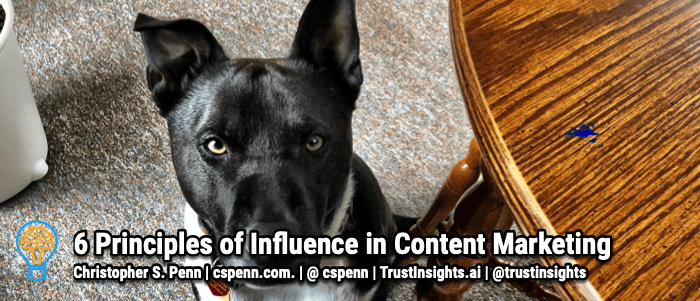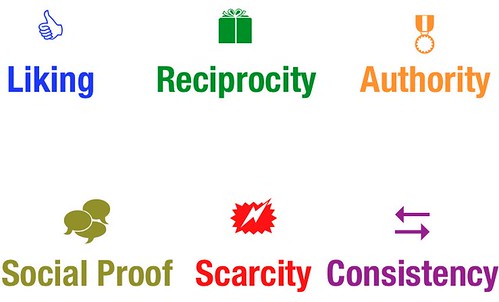
How do we make our content more valuable? In the most recent CMO Survey, CMOs are demanding greater impact from marketing activities as their top priority by a wide margin. Why would such a demand exist in the first place? The answer: marketing activities aren’t delivering impact – not real business impact.
What sort of impact are marketers looking for? People taking action, doing business with our companies. So, why wouldn’t people be doing business with us? One part of the answer is that our marketing lacks influence. Great content is the bucket everyone aspires to – content that’s remarkable, content that’s unique, content that’s memorable.
What’s missing from this perspective is content that’s influential – that convinces people to take meaningful action towards doing business with us. Why is this key ingredient missing from our content? Part of the reason is that we don’t have a very good idea of what influence is; in recent times, influence has been conflated with popularity, and the two are very different. Our content may be popular, but based on CMOs’ demands, it’s not influencing people to take action.
So, how do we make our content, our marketing more influential?
In 1999, Dr. Robert Cialdini postulated 6 principles of influence and persuasion that can be leveraged to make influence and persuasion techniques more effective. Let’s take a look at these and how they might be able to improve the influence of our marketing. The 6 principles are:
- Reciprocity. People tend to return a favor and honor social debts.
- Consistency. People will tend to honor a commitment and be consistent with previous behaviors.
- Social proof. People tend to follow the herd.
- Authority. People tend to obey authority figures.
- Likeness. People tend to be influenced by those they are like and those they like.
- Scarcity. People tend to act faster under the perception of scarcity.
How would each of these principles be used in content marketing?
Reciprocity. Offer your audience something of value. This may be content, or it may be a material good or service. Whatever it is, Cialdini’s version of reciprocity does not necessarily enforce a quid pro quo. Give, and then ask after you’ve gained influence with them. Of all the techniques, digital marketers tend to make use of this the most, because it’s the simplest to understand and execute on.
Consistency. People tend to behave consistently, aligned with previous behaviors. Cialdini cites the example of going around the neighborhood with a petition for a cause and then going around again a week later soliciting donations for the cause. Donors nearly doubled with the use of the petition because people wished to be consistent with their previous signature of the petition. Think about how you can use behavioral consistencies – subscribing to an email, following someone on a social network, taking a poll or survey, etc. – to create a behavior and then use a followup marketing campaign to elicit the response you seek.
Social proof. Properly executed, social media can radically change your content marketing. Every time someone shares, comments, engages, or likes your content, they’re implicitly endorsing it, creating social proof that your content marketing has value. Encourage and incentivize your audience to share as much as possible.
Authority. Presumably people consume your content because you have some degree of knowledge and authority, enough credibility for people to want to read what you have to say. Provide people with the tools they need to become authorities in their own social circles and your content marketing will be unstoppable. For example, when it was founded, Peter Shankman’s Help a Reporter allowed PR and marketing professionals to have free access to journalism inquiries that they otherwise wouldn’t have gotten. Not only was Shankman an authority on PR, but he empowered each of his subscribers to become authorities in their respective companies, creating press and earned media opportunities seemingly out of thin air.
Likeness. How well do you know your audience? For good or ill, we are easily persuaded by people who are like us, or are people we like. Narrowly, social media certainly provides plenty of ways to identify people just like you, such as Facebook’s Graph API. More broadly, think about the imagery and language in your content marketing and whether it’s aligned to your audience. If your marketing data indicates that your audience is largely Hispanic, having content and imagery focused on Swedish personas will simply not resonate.
Scarcity. Whatever you have to offer, there’s a way to make it scarce. It could be a time limited special offer, or a limited quantity. It could be your time and knowledge in a consulting capacity about a subject matter you have expertise in. Find a way to bring some scarcity to what you have to offer.
Influence is all about compelling people to take action. How compelling is your marketing? Does it drive action? If not, consider using some of Dr. Cialdini’s principles to make your marketing more influential.
You might also enjoy:
- Mind Readings: You Need Passwords for Life in the Age of Generative AI Fraud
- Almost Timely News, January 14, 2024: The Future of Generative AI is Open
- Mind Readings: Most Analytics Data is Wasted
- Almost Timely News: Principles-Based Prompt Engineering (2024-02-25)
- You Ask, I Answer: Retrieval Augmented Generation vs Fine-Tuning?
Want to read more like this from Christopher Penn? Get updates here:
 Take my Generative AI for Marketers course! |



Leave a Reply